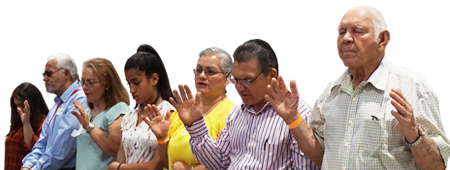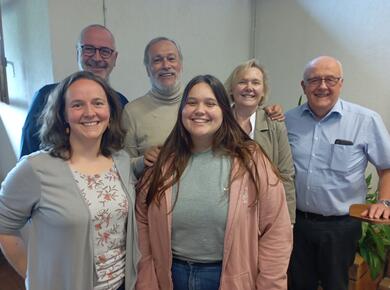Posted: June 26, 2024
Peace Sunday 2024 Teaching resource
Reading Scripture has always been at the heart of the church’s life, but from early on, different ways of reading and understanding have led to conflict and division.
What is Scripture?
Already in the early centuries several movements arose with differing claims about the meaning of the Gospel and how to understand Scripture. In the 2nd century, Marcion (c. 85-160 CE) refused to recognize the Scripture of the Jewish people, writings which Christians had used from the beginning. He founded a new and large church which used only Marcion’s edited canon of Paul’s epistles and the Gospel of Luke. During this same period, Gnosticism was making headway, denying the Incarnation and claiming the true knowledge came from the “secrets” of “those who know”, and composing their own Gospels.
Irenaeus was born around 140 in Asia Minor, moved to Lyon (in today’s France) where he became bishop. As part of his ministry, he wrote to argue against Marcion and the Gnostics. Irenaeus recognized the challenge represented in trying to make sense of the many narratives in Jewish Scripture, which the church interpreted in the light of our Gospels and many epistles that were also commonly accepted as Scripture during this time, since the New Testament as we now know it was not yet finalized.
A king or a fox?
One way that Ireneaus dealt with this question was to describe Scripture as a mosaic. He used the image of the Bible as a beautiful image of a king, constructed by a skillful artist out of precious jewels. What happened with other readings such as those of Marcion or the Gnostics was to take the mosaic apart, reshuffling the pieces so that the final image was no longer a king, but something else, such as a fox.
In Irenaeus’s mind, the king was of course Jesus. The bishop of Lyon was part of the church when it was still a persecuted minority and had not aligned itself with the political power of the Roman empire. In this context, king Jesus was not like the Roman Caeser, but the nonviolent Christ of the Gospels, much the same as in the Anabaptist tradition.
Along with other theologians of this period, Irenaeus understood the incarnation as a profound reflection of God’s nature, the God whose self-giving love on the cross and resurrection redeemed humanity from captivity to Satan who used violence to keep humanity imprisoned. For Irenaeus, the mosaic of Scripture, i.e., its proper reading, was to point to this Jesus and not to another; not to change the king into a fox. His theology has continued to influence the church up until today. In 2022, for example, Pope Francis attributed to Irenaeus the title of “doctor of unity.”
Irenaeus’s solution of course did not solve the problem. Differing readings of Scripture persisted. During this same period the early church recognized that guideposts were necessary for this kind of reading of Scripture.
Rules to guide
These guideposts were called “rules of faith,” and Scripture was to be interpreted in line with the guideposts. They left a lot of room for discussion, but also set limits beyond which the king would become a fox. The first rules of faith were formulated in reaction to Marcion and Gnosticism, and the process has gone on ever since.
Mennonite World Conference’s understanding of the “king” in the mosaic is close to that of Irenaeus. Jesus, who announced God’s kingdom and was crucified as the “king of the Jews”, taught and lived nonviolence. His acceptance of death on a cross corresponded to his rejection of hatred and vengeance, his resurrection signaled the defeat of death and evil.
Unfortunately, throughout her history, the church has sometimes turned the “king” into a “fox,” using Scripture to construe a Jesus who called Christians to fight and to make war. The Anabaptist movement reacted to these restructurings of the mosaic.
Shared Convictions
In more recent times, MWC member churches together produced guideposts to the reading of Scripture which are called “Shared Convictions.” The fourth of these seven convictions recognizes the importance of Scripture.
As a faith community, we accept the Bible as our authority for faith and life, interpreting it together under Holy Spirit guidance, in the light of Jesus Christ to discern God’s will for our obedience.
The fifth conviction depicts an understanding of Jesus close to that of the early church.
The Spirit of Jesus empowers us to trust God in all areas of life so we become peacemakers who renounce violence, love our enemies, seek justice, and share our possessions with those in need.
Ireneaus described the mosaic of Scripture as a “collection of jewels”. But the narratives that come to us in the Bible tell of much brokenness. Brokenness of relationships, between humanity and God, between humans, as well as humanity’s relationship with nature. The “jewels” of Scripture tell stories of a broken world, of violence, of rejection and abuse.
But the real jewel is the narrative of God’s faithfulness, God’s determination to make things right, through self-giving love. God, in Christ, is taking the broken aspects of our lives and of the world and working to make things right, to reconcile. To that, we are called to witness, through deed and word and through our common life as a global fellowship.
The seventh shared conviction reflects this project of reconciliation and healing and incorporates it into the life of our communities.
As a world-wide community of faith and life we transcend boundaries of nationality, race, class, gender and language. We seek to live in the world without conforming to the powers of evil, witnessing to God’s grace by serving others, caring for creation, and inviting all people to know Jesus Christ as Saviour and Lord.
To transcend these boundaries, we must be aware of the narratives of brokenness in Scripture and in our lives that God is redeeming through self-giving love. Then the mosaic of the world-wide fellowship is comprised of brokenness turned into jewels.
—Neil Blough is former director of the Paris Mennonite Centre and professor emeritus of church history at Faculté Libre de Théologie Évangélique Vaux-sur-Seine, France.


Join the Conversation on Social Media
FacebookTwitterInstagramFlickrYouTube